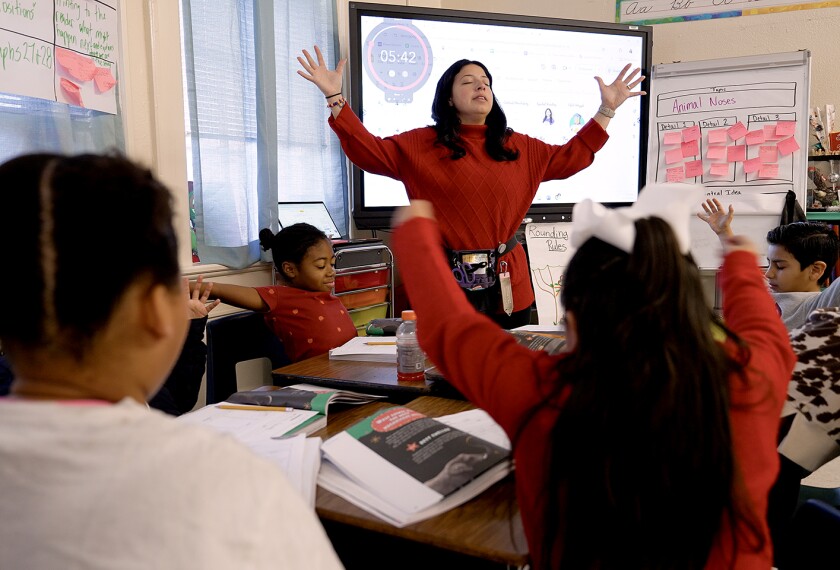Imagine you’re a student-athlete just starting out in a team sport. Your opponent is winning, the spectators are loud, there are only a few minutes left, and you’re feeling a lot of pressure. Your coach calls out from the sidelines: “Focus out there!” But you’ve never learned how to effectively block those outside pressures.
That’s where a social-emotional-learning curriculum that helps students self-regulate and manage stress would be useful for students and coaches, said Mitch Lyons, the founder of a handful of nonprofit organizations, such as GetPsychedSports.org, that advocate for social-emotional learning and cultivating supportive environments in school athletics.
The Massachusetts state legislature is considering a bill that would require its education department to publish guidelines for a social-emotional-learning curriculum in middle and high school athletic programs.
Lyons brought that issue to the attention of state Senate Majority Leader Cynthia Creem and worked with the Democrat’s office to write the bill, according to Lyons and Creem’s office. He was inspired to champion incorporating SEL into K-12 athletics after seeing what he described as coaching behavior that was abusive.
“That’s when I started looking at, why is this happening in sports?” said Lyons, who lives in Massachusetts. “There was no main message in the athletic department. There’s no, ‘This is something we will be teaching on all teams.’ It’s every coach [doing their own thing].”
With sports, SEL happens ‘in real time’
Sports is a great place to practice social-emotional-learning skills, according to experts. Young people learn skills such as teamwork, sportsmanship, and resilience while playing sports.
“It’s happening in real time,” said Megan Bartlett, the founder of the national nonprofit Center for Healing and Justice Through Sport. “In a sports environment, you’re having real-life interactions with other people, you’re having stressful things happen that cause you to need to practice regulating your emotions.
“And you can get coaching on it in real time,” Bartlett added.
If a student-athlete feels like an opponent bumped into them too hard or doesn’t like what’s happening during the game, a coach can intervene and help the athlete regulate their emotions.
While those skills are often taught implicitly, students should also be taught SEL skills explicitly the same way sports-specific skills—such as how to pass a basketball or how to do a butterfly stroke—are taught, Lyons said.
Andrew Tucker, the director of policy for the nonprofit Collaborative for Academic, Social, and Emotional Learning, or CASEL, agreed that explicit teaching is “proven to be effective in building these types of environments where students can grow and learn new skills.” CASEL has been a major force in promoting the adoption of SEL state standards and promoting research-based SEL instruction.
But explicit teaching doesn’t mean that the student-athletes have to sit and listen to a lesson like they’re in the classroom, Tucker said. It’s all about incorporating these skills in the context of the sport.
“There are all kinds of teachable moments in sports,” he said. “You lose a game, you’re really down on it. How do you as a coach lift your team back up? Do you teach them that this is one game, that these emotions you’re feeling are valid? What are you feeling, and why are you feeling that way? How can we get you to a place where you’re feeling OK?”
Coaches need more training
However, coaches often don’t have the resources they need to teach their student-athletes the necessary social-emotional skills to overcome obstacles they might face in competitions and in life, according to experts.
“I think it’s mostly that it just has never been the expectation,” Bartlett said. “The expectation is if you do need training, it’s in tactics for your sport. It’s how to become the smartest basketball mind, not the best developer of young people.”
Often, coaches are volunteers and not paid well, if at all, so they don’t want to add more to their plates, said Hannah Olson, the director of the Center for Leadership in Athletics at the University of Washington, a research center focused on improving leadership and management practices in athletics.
It could also be that, in the past, teachers were almost always the ones coaching, and “the expectation is that a teacher would know those fundamental things,” Bartlett said.
Liz MacLachlan, a high school physics teacher and cross-country coach in Providence, R.I., agreed that for her, incorporating SEL in coaching “comes easier to me with my understanding and training in the classroom.”
“I think everyone kind of knows what we want coaches to be doing, but actually the work of implementing it is a skill,” MacLachlan said. “It’s not easy and obvious how to create [safe, supportive environments]. It takes understanding what you want, verbalizing it clearly, and then in the moments where it’s challenged, being able to turn to kids and say, ‘This is not the environment we’re creating.’”
‘Positive’ development
The Massachusetts bill specifies that an SEL curriculum in middle and high school athletics should explicitly teach students and coaches how to:
- Create a safe, supportive, and bias-free team culture;
- Provide students with age-appropriate leadership roles;
- Formulate lessons and guidance that address hate, bias, and negative behaviors;
- Build and sustain positive relationships with others; and
- Develop other skills that would assist them in overcoming physical, social, and emotional obstacles in athletic competition and in their lives.
The bill does not mandate that school districts adopt an SEL curriculum for athletics. Instead, it would require that the state set guidelines for districts if they choose to incorporate it.
“For a hundred years or more, we’ve thought of youth athletics as a way to impart values and skills like hard work, determination, cooperation, problem-solving, and emotion management, but we don’t have any curriculum in place to ensure that our teams live up to that purpose,” Creem said in an email to Education Week.
The Massachusetts Interscholastic Athletic Association, which governs school athletics in the state, did not immediately respond to requests for comment on the bill, which is set for a public hearing in early May.
Other state legislatures are also looking to address these issues in youth sports. In New Jersey, three assembly members introduced a bill that would establish a task force to examine issues and make recommendations concerning youth sports, including abusive coaching, confrontational parents, and bullying of players. Utah lawmakers passed a joint resolution that condemns abusive coaching practices and calls on schools to provide safe and supportive environments for student-athletes. Although these deal with social-emotional-learning concepts, they don’t mention SEL by name.
“Any move toward finding a way to provide coaches with more education and opportunities to learn is really positive,” Olson said. “I think they’re moving in the right direction.”







